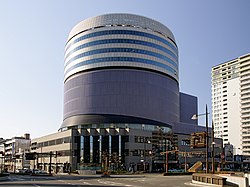Yoshinobu Ashihara
Yoshinobu Ashihara | |
|---|---|
芦原 義信 | |
| Born | 7 July 1918 Tokyo |
| Died | 24 September 2003 (aged 85) Tokyo |
| Nationality | Japanese |
| Alma mater | University of Tokyo |
| Occupation | Architect |
| Known for | Sony Building, Komazawa Gymnasium |
Yoshinobu Ashihara (芦原 義信, Ashihara Yoshinobu, 7 July 1918 – 24 September 2003) was a Japanese architect noted for projects such as the Komazawa Olympic Gymnasium (1964) and the Sony Building (1966).
Education and career
Ashihara was educated at both the University of Tokyo and Harvard University. After graduating from Harvard in 1953 with a master's degree in Architecture, Ashihara worked in the architectural practice of modernist Marcel Breuer. Founder of his own firm Yoshinobu Ashihara Architecture Associates in 1956.
In the later stages of his career, he was appointed Professor of Architecture at the University of Tokyo. President of the Japan Institute of Architects from 1980 - 1982 and the Architectural Institute of Japan from 1985 - 1987.[1]
He was the recipient of both the Order of the Sacred Treasure and the Order of Culture.
Projects
| Project | Date | Location | Image | |
|---|---|---|---|---|
| Komazawa Olympic Gymnasium and Control Tower[2] | 1964 | Setagaya, Tokyo | 
| |
| Atelier, Musashino Art University[3] | 1964 | Kodaira, Tokyo | ||
| Sony Building[3][4] | 1966 | Ginza, Chūō, Tokyo | 
| |
| Fuji Film Building[3] | 1969 | Minato, Tokyo | ||
| National Museum of Japanese History[3] | 1980 | Sakura, Chiba | 
| |
| Headquarters, Daiichi Kangyō Bank[3] | 1981 | Chiyoda, Tokyo | 
| |
| Gotenshita Memorial Arena, University of Tokyo[3] | 1989 | Hongō, Bunkyō, Tokyo | ||
| Tokyo Metropolitan Theatre[3][5] | 1990 | Toshima, Tokyo | 
| |
| Okayama Symphony Hall[6] | 1991 | Okayama, Okayama | 
| |
| Film Centre, National Museum of Modern Art, Tokyo[7] | 1994 | Chiyoda, Tokyo | 
| |
| Ishikawa Ongakudō[8] | 2001 | Kanazawa, Ishikawa | 
|
Publications
Ashihara published a large number of architecture focused studies and texts, most prominent being The Aesthetic Townscape (Japanese first edition 1979 and English translation in 1983) and the Hidden Order: Tokyo through the Twentieth Century (Japanese first edition 1986, English translation in 1989).
See also
References
- ^ "Yoshinobu Ashihara - Biography". Yoshinobu Ashihara Digital Forum. Archived from the original on December 2, 2011. Retrieved 6 March 2012.
- ^ "Komazawa Olympic Gymnasium and Control". Yoshinobu Ashihara Digital Forum. Archived from the original on October 4, 2013. Retrieved 6 March 2012.
- ^ a b c d e f g Watanabe Hiroshi (2001). The Architecture of Tōkyō. Edition Axel Menges. ISBN 3-930698-93-5.
- ^ "Sony Building - History". Sony. Retrieved 6 March 2012.
- ^ "Tokyo Metropolitan Art Space Concert Hall". Nagata Acoustics. Archived from the original on February 16, 2012. Retrieved 6 March 2012.
- ^ "Ishikawa Ongakudo Concert Hall". Nagata Acoustics. Archived from the original on February 16, 2012. Retrieved 6 March 2012.
- ^ 1990年代 (in Japanese). Yoshinobu Ashihara Digital Forum. Archived from the original on August 23, 2011. Retrieved 6 March 2012.
- ^ "Ishikawa Ongakudo Concert Hall". Nagata Acoustics. Archived from the original on February 16, 2012. Retrieved 6 March 2012.
External links
